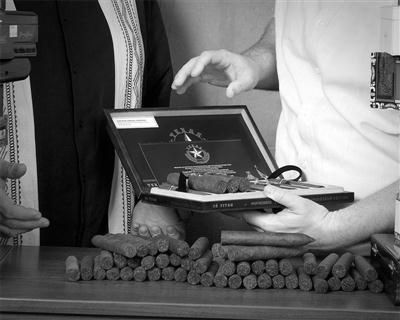MADURO 101

Dark and as rich tasting as the earth from which they grow, Maduro-wrapped cigars are a favorite among many. They are the darkest of all the various shades of brown, and provide a wide array of tastes, from a sweet, mellow flavor to a robust and hearty taste that only the most seasoned smoker could appreciate.
"Maduro" is the Spanish word for "ripe" and is use cigar-wise to refer to the extra time required and the dark colors achieved during the natural fermentation of maduro wrappers. Typically these wrappers are oily, plush with flavor, and earthy to the nose.
As with all wrapper colors, there is a wide array of variance between subtle shades of brown, but there are three primary Maduro color groups:
Colorado Maduro (dark brown) - This color is found on some of the fullest flavored cigars in the world. Typically, these are sun-ripened and are sometimes referred to as "EMS" or "dark EMS."
Maduro (very dark brown) - This color is also occasionally referred to as "Spanish Market Selection" (SMS) because of the Spanish nation's love of dark, full-bodied cigars.
Oscuro (basically black) - Also referred to as "Double Maduro or "Maduro Maduro."
Now here is where things get a little confusing: The term "Maduro" can be used to describe solely the color of a wrapper, or it can be used to actually refer to the process of creating a Maduro wrapper leaf. In short, a cigar can be Maduro in color, but not actually a Maduro wrapper and vice versa, while a wrapper can be fermented using the methods that create natural Maduro wrappers, but the resulting color may be on the lighter end of the Maduro color spectrum.
Traditional hand-worked Maduro wrappers are the result of two separate processes. The first is utilizing leaves selected from the top 2/3 of the plant. The additional sun ripening provides the sweetness associated with Maduro wrappers. This is due to photosynthesis creating added sugar in the leaves. Also, the heavier oils for which Maduro wrappers are noted are the result of the plant's natural defenses; the leaf creates additional oils trying to protect itself from the sun's glare. Whether the leaf will become a mild- or a full-flavored Maduro wrapper is generally determined by where on the plant the leaf was selected. The leaves at the top of the plant produce full-flavored wrappers, whereas the middle leaves produce a milder wrapper.
In addition to extra sun ripening, Maduro wrapper leaves are fermented longer and at a higher temperature. Natural wrappers will be fermented to between 100 and120 degrees for most varieties, while Maduro wrappers are fermented at higher temperatures, sometimes as high as ~150 degrees before being cased and turned. This extended high temperature fermentation turns the leaves the dark brown Maduro color. The longer the fermentation period, the darker the color, and the milder the wrappers will become. Also, only certain tobacco varietals' leaves can be used to create naturally fermented Maduro wrappers, as the tobacco must have sufficient body to withstand the higher fermentation temperature and lengthened bulk durations. Connecticut Broadleaf, Habana 2000, and Mexican Sumatran are the two strains most commonly used in the creation of Maduro wrapper leaf.
In the past, some manufacturers have been known to add weight atop of the pilones, thereby pressing the leaf tighter, which increases the internal temperature of the fermentation process. This is referred to as "press fermentation." Some factories also break apart the bulks, and allow the leaves additional time exposed in the sun between fermentation cycles. There are a variety of other techniques utilized to refine this time-honored process, but many remain closely held secrets by the tobacco men who work this dark leaf.
Now it is time to introduce two other methods implemented to create Maduro wrappers. The first is "cooking," which more accurately described is actually steaming. In this process, the leaves are placed within a steam chamber for a period of 60-120 minutes and steamed at 180+ degrees Fahrenheit. The result is a very dark wrapper that is very consistent in color. Some hold in contempt this method, but actually this is the method that is most commonly used to create the wrappers used on most of the milder Maduro cigars. Although this is a much simpler and shorter process, the maker has to be vigilant, as it is possible to overcook the leaf resulting in a dull, flat-tasting wrapper with a silvery, gray appearance. The other alternative method is dying the leaves the desired dark brown color. This is done in a variety of ways - from sluices, vats, to even a machine that is snidely referred to as the "Madu-O-Matic" by those in the trade. This machine can "create" Maduro wrappers at a blazing pace and, typically, makers will add sugar to the molasses-like dye to sweeten the flavor of the leaf. This process is considered "cheating" by many in the industry, and is held in low regard by many traditional tobacco men. As a consumer, it is easy to detect whether your Maduro cigar is a faux, because most dyed Maduro cigars will actually leave a slight brown stain right on lip of the smoker.
We love a good Maduro cigar. With all of the potential variables, the maker has the ability to create as dark, sweet, mild-, or full-bodied a cigar as desired and, in turn, give the cigar smoker a wide variety of taste treats to from which to choose.
